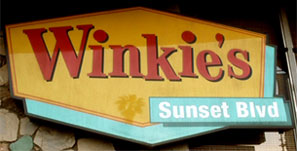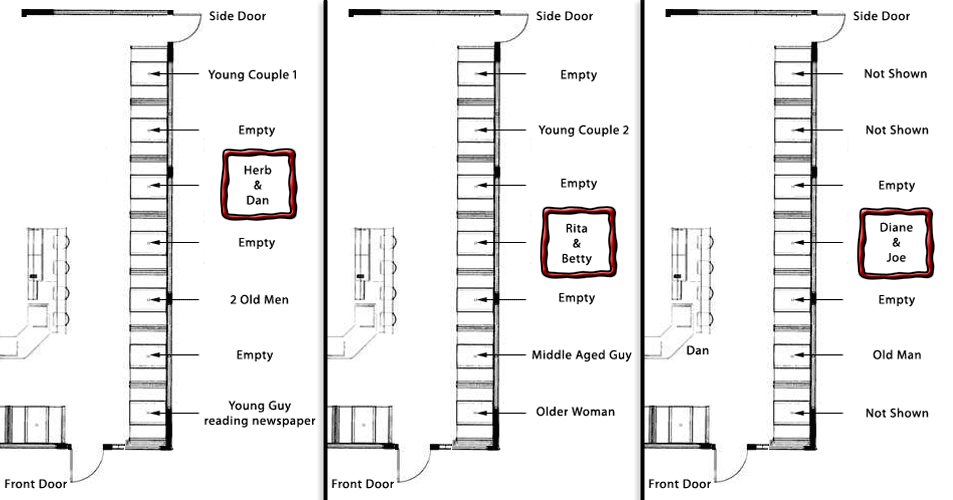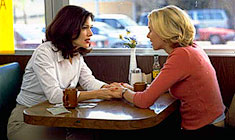|
|
Threads: |
Related: |
First we see two men sitting at a table next to the window, face to face. One in his early forties, obviously dominant, sometimes even showing his irritation as if he was wasting his time, the other much younger, very submissive, in a pleading attitude. They seem to be a couple, or at least former partners in life. The younger, with his back to the door, is telling about the nightmare that haunts him every night.
Later we can see the two main characters, Rita and Betty, sitting in this restaurant, at the same table where the two men had been before. The blond girl, Betty, is sitting exactly where the "dreamer" was. And the brunette, Rita, is exactly where his friend was. What is the interest of this coincidence? Actually it reveals what role the two women embody during the first part of the movie. The blond girl is the dreamer: she imagines all the "pink part" of the movie because she canít bear the reality. And like the dreamer, she is the weaker of the pair, while the brunette is the dominant one in the real world, as is revealed later.
What we can finally notice is that the "dreamer" and his partner seem to be gay, like Diane is a lesbian, and has an affair with Camilla, just another clue which helps us to find the links between the two scenes. - (Charlotte Dekens & Stijn Creemers)
Point of no return
In one flashback
scene, we are at Winkie's with the hitman. Diane fixates on different things for various reasons, but that does not mean that there is reciprocal interest being focused on her. Even the man
at the cash register did not start looking in Diane's direction until after Diane looked at him. Therefore, unlike a few other reviewers, I don't believe that the man at the cash register is a witness who can turn Diane in to the police. Instead, I think Diane's hitman was careful in what he said so as not to alert anyone who may be listening in or watching. The significance of the scene is to show us that Diane sees things like the man, the waitress and the key as certain types of symbols marking her movement up to the point of no return, and then her passing that point. The key represents the point of no return.
The name of the waitress, "Betty," is what she saw before seeing the key, while the man, "Dan," is who she saw after seeing the key.
Therefore, the name Betty is the connected to the image of her innocence because it is associated with the time before the key, while Dan is the doomed one who is killed by her demons because he is associated with the time after the key. With this in mind, when Diane asks the hit man what the key opens, her own associations tell us the answer to that question.
- (Alan Shaw)
 The presence of the bum is a self-fulfilling prophesy connected to a place like Winkie's, where food is kitsch
- mass-produced junk to fit the fantasy aesthetic of an all-American breakfast
- and the leftovers of which, whether the dross of food-factory production or that which diners leave unconsumed, is discharged as waste into dumpsters behind the restaurant. In this un-Disneylike "circle of life," the bum feeds on the waste of this institution
- on the waste people don't feel like eating, and because we are what we eat, the bum eating waste is also the waste, or shit, of the society supporting the fast-food institution. That "god-awful feeling" about the man behind Winkie's as the one who's doing it translates into a collision between Dan's dream/fantasy outside and the reality of the bum.
The presence of the bum is a self-fulfilling prophesy connected to a place like Winkie's, where food is kitsch
- mass-produced junk to fit the fantasy aesthetic of an all-American breakfast
- and the leftovers of which, whether the dross of food-factory production or that which diners leave unconsumed, is discharged as waste into dumpsters behind the restaurant. In this un-Disneylike "circle of life," the bum feeds on the waste of this institution
- on the waste people don't feel like eating, and because we are what we eat, the bum eating waste is also the waste, or shit, of the society supporting the fast-food institution. That "god-awful feeling" about the man behind Winkie's as the one who's doing it translates into a collision between Dan's dream/fantasy outside and the reality of the bum.
Trivia
-
A reference: In "The Wizard of Oz" the Winkies were the little people living in the west who were dressed all in yellow, enslaved by the Wicked Witch of the West, and later freed by Dorothy. ĽThe Wizard of Oz connection
-
 Dan mentions that it has to be
THIS Winkie's
because his dream takes place during "half night". THIS Winkie's
is of course on Sunset Blvd, the "Boulevard of broken dreams".
Dan mentions that it has to be
THIS Winkie's
because his dream takes place during "half night". THIS Winkie's
is of course on Sunset Blvd, the "Boulevard of broken dreams".
Ľmovie references -
Reportedly, the original Winkie's diner (1016 W. El Segundo Blvd.) featured the same brown coffee cup and plates that were used in the movie.
-
The Denny's restaurant on the corner of Cower and Sunset was an inspiration for Winkie's and the restaurant used to be called 'The Copper Penny'. To Lynch the bum outside was a vibe of the weirdness he felt when being in a specific booth at this restaurant and gave him sort of a strange feeling and that others felt something too. (Book: Lynch On Lynch)
-
Lynch on the unsettling camera work in the Dan & Herb scene:
"That was always part of the idea. Part of the nightmare. The crew had to get a special jib arm and work it into a narrow diner and get it so that Peter Deming and the camera could just float. The floating never really stops; it's like drawing a figure of eight forever." (Book: Lynch On Lynch)
Winkie's table map (woodlouse)
|
Herb & Dan talking about the monster |
Rita & Betty reading papers |
Diane & Joe with money and a blue key |

